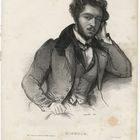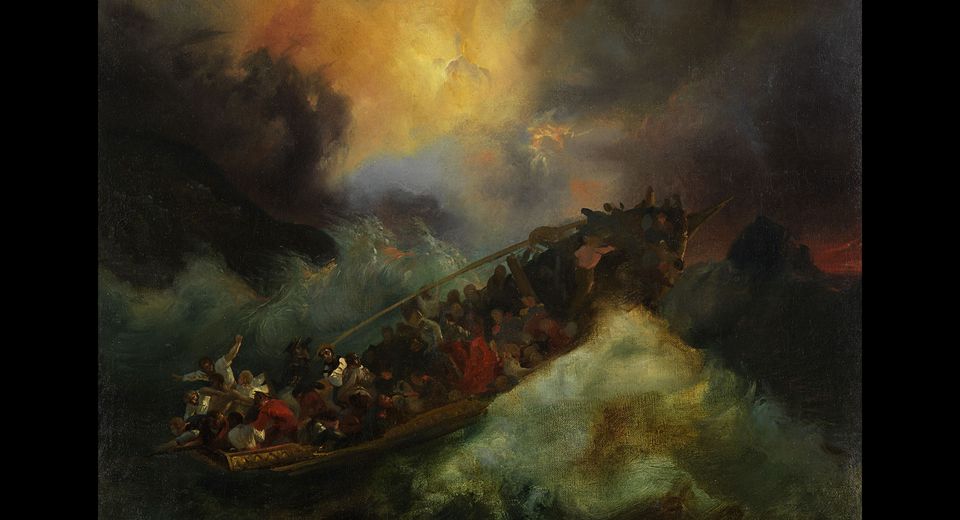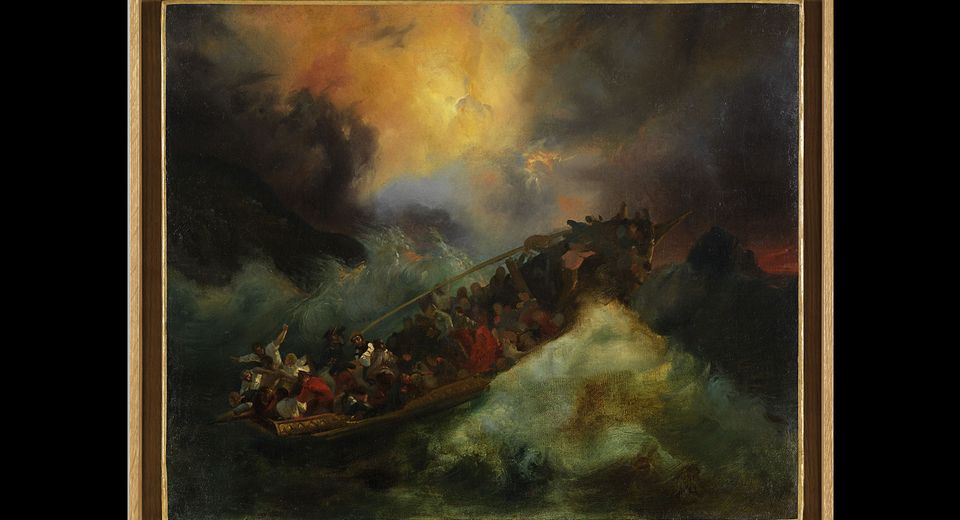Gale in Algiers Harbour, Théodore Gudin
Port-Louis
Preparatory painting
This preparatory painting produced during the Algerian campaign by Théodore Gudin testifies to the strong gale suffered on January 7, 1831 by the French Navy in the harbor of Algiers.
Description
Théodore Gudin was appointed Official Painter to the Navy in 1830 and took part in the Algeria campaign the same year. It was in this context that he carried out the preparatory work for the canvas depicting the gale that struck the French Navy in Algiers harbour on 7 January 1831. This preparatory painting preceded a large-format work that was presented at the Louvre’s Painting and Sculpture Salon in 1835 and contributed to his reputation.
In 1823, Théodore Gudin looked on powerless to act as his brother drowned in a shipwreck on the Seine. Deeply affected by this tragic event, he was one of the founders of the Central Shipwreck Rescue Society (SCSN), whose Vice-President he became in 1865. Appointed Official Painter to the Navy in 1830, he set off for the Algerian campaign the same year along with the painters Isabey and Langlois and, pencil at the ready, followed the French troops in order to illustrate the conquest’s highlights, including the attack on Algiers and the explosion of Bordj Moulay Hassan (the Emperor’s Fort ).
On 7 January 1831, the French fleet was caught in a major gale: at around 9 o’clock in the morning, troops were being transported to the sixty-gun frigate La Syrène aboard two small Mediterranean warships known as xebecs, when gale-force winds drove the vessels towards the coast. Gudin made a sketch of the event: One of the xebecs forms a central feature of this small-format work, whilst the other is scarcely sketched in. The faces of the sailors in the front of the boat are only depicted by a few touches of pure colour whereas those at the back are rendered in much greater detail, in the same postures as in the final painting. But the most remarkable thing about the work is the intensity with which Gudin depicted the raging sea and stormy skies, drawing on a complex palette of bright colours and making clever use of chiaroscuro. This preparatory painting preceded a large-format work that was presented at the Louvre’s Painting and Sculpture Salon in 1835 and contributed to his reputation.

Théodore Gudin
Along with Louis-Philippe Crépin, he was one of the first two Official Painters to the Navy.
Théodore Gudin was born in Paris on 15 August 1802.
At the age of 17, Gudin abandoned his studies and set off to New York, where he set sail on a brig entrusted with surveillance of cod fishing on Newfoundland’s Great Banks. He found out how hard life at sea was along the way. Three years later, with this experience under his belt, Gudin returned to France and, following in his brother Louis’ footsteps, became a painter.
Gudin and his work soon attracted attention and he was given several commissions. In his book Souvenirs, published in 1921, his son-in-law portrays him as a “courtier artist”, familiar with all the crowned heads of Europe.
His prolific body of work includes pure seascapes along with shipwreck scenes, storms and scenes of contemporary history.
Collection highlight
The essential works to see during your visit to the Musée national de la Marine in Brest, Port-Louis, Rochefort, Toulon, and soon in Paris.


